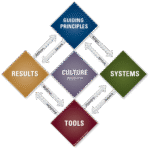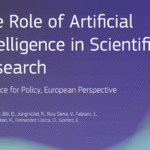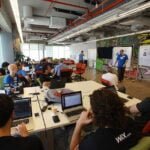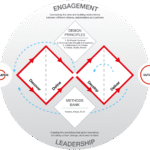In the face of growing environmental degradation and unsustainable resource consumption, the concept of circular economy has emerged as a promising alternative to the traditional linear model of “take, make, dispose.” The circular economy is an approach to addressing environmental challenges and promoting sustainable development, which has been receiving increasing attention in industrial development discussions (Korhonen et al., 2018).
The concept of circular economy has gained significant attention in recent years as businesses, governments, and individuals recognize the need to move away from the traditional linear economy. The circular economy offers a range of opportunities, including reducing environmental pressure; increasing the security of raw material supply; boosting competitiveness, innovation, growth, and job creation.
In this article, we aim to answer the question, What is the circular economy in practice, and how does it differ from the linear model?, to provide you with a general overview of the key concepts underlying the circular economy and the steps you should take to orient your business model towards circularity.
What is the circular economy?
The circular economy (CE) is an economic system aimed at eliminating waste and the continuous use of resources. One of the most widely accepted definitions of the circular economy is proposed by the Ellen MacArthur Foundation, which states that the “circular economy is a systems solution framework that addresses global challenges like climate change, biodiversity loss, waste, and pollution.” Similarly, the World Economic Forum (2014) highlights that the circular economy is an industrial system that is restorative or regenerative by intention and design.
The European Parliament (2016) defines the circular economy as “a model of production and consumption that involves sharing, leasing, reusing, repairing, refurbishing, and recycling existing materials and products as long as possible to create added value.”

The circular economy is an economic concept that is interconnected with sustainability, aiming to maintain the value of products, materials, and resources (water, soil, energy, etc.) in the economy for as long as possible, while minimizing waste generation (Fundación para la Economía Circular).
For Korhonen et al. (2018), the circular economy is “a sustainable development initiative aimed at reducing the linear flows of materials and energy from society’s production-consumption systems by applying material cycles, renewable energy flows, and cascade-type energy flows to the linear system.” However, there is currently no consensus on the definition of the circular economy; in this regard, the study by Kirchherr et al., (2023) provides valuable insights into the evolution of CE definitions and highlights the importance of a shared understanding for progress in the field. The researcher points out that a consensus definition can play a crucial role in guiding policy-making, industrial practices, and research efforts.
The circular economy approach shifts away from the extractive industrial model towards one that promotes sustainability, where waste is reduced, and the product life cycle is extended through recycling, repair, refurbishment, and remanufacturing. This approach allows for innovation in product manufacturing.
Principles of Circular Economy
The circular economy follows the 3R approach: reduce, reuse, and recycle. Resource use is minimized (reduced); product reuse is maximized; and lastly, raw materials are reused (recycled). According to the Ellen MacArthur Foundation, the circular economy is based on three design-driven principles:
- Eliminate waste and pollution: Waste does not exist; products are designed and optimized for a cycle of disassembly and reuse.
- Circular products and materials: Circularity introduces a strict distinction between the consumable and durable components of a product. Consumables in the circular economy are largely made from biological ingredients or “nutrients” that are at least non-toxic and possibly even beneficial, and they can be safely returned to the biosphere.
- Regenerate nature.
Elements of the Circular Economy
Korhonen et al. (2018) emphasize that definitions of the circular economy focusing on system change highlight three key elements:
- Closed cycles: In a circular economy, material cycles are closed, following the example of an ecosystem. There is no need to think of waste, as it is used to make new products.
- Renewable energy: Circular economy systems are powered by renewable energy sources. Since energy cannot be recycled, “cascade-type energy flows” are emphasized. One example is the co-production of heat and power.
- Intelligent systems: Every actor (company, person, organization, etc.) in the circular economy is linked to other actors. Together, they form a network where the actions of one actor influence others.
Flow of the Circular Economy: A Regenerative System
In a circular economy, the flow of materials fundamentally differs from the linear model. Instead of materials moving in a straight line from production to disposal, the flow of the circular economy emphasizes the continuous circulation of products and materials. This can include recycling materials into new products, reusing products for different purposes, or remanufacturing goods to extend their lifecycle.
The closed-loop system of the circular economy not only conserves resources but also reduces pollution and greenhouse gas emissions, aligning with broader sustainability goals.
Linear Economy vs. Circular Economy
The key distinction between the linear economy and the circular economy lies in their respective approaches to resource management and waste. In a linear economy, raw materials are extracted, turned into products, consumed, and discarded, often ending up in landfills or incinerated. This model not only depletes finite resources but also generates significant amounts of waste, contributing to environmental degradation.
In contrast, the circular economy seeks to “close the loop” by designing products that can be disassembled, repaired, and recycled, thereby minimizing waste and maximizing resource efficiency. A practical example can be seen in the shift from single-use packaging to reusable or recyclable materials. This reduction in waste is not only beneficial for the environment but also economically advantageous, as it can lower production costs and create new revenue streams through resource recovery.
The circular economy replaces the concept of end-of-life with restoration, shifting towards the use of renewable energy, eliminating the use of toxic chemicals that hinder reuse and return to the biosphere, and aiming to eliminate waste through superior design of materials, products, systems, and business models (Ellen MacArthur Foundation, 2013).

In Table 01, I presented a comparison between the linear economy and the circular economy, highlighting their key differences in aspects such as resource use, waste management, and environmental impact:
Table 01. Comparison between the linear economy and the circular economy.
| Aspect | Linear Economy | Circular Economy |
|---|---|---|
| Production Model | “Take, make, dispose.” | “Reduce, reuse, recycle.” |
| Resource Use | Continuous extraction of new natural resources. | Efficient use of resources, prioritizing reuse and recycling. |
| Product Design | Products designed for a short life cycle, difficult to repair or recycle. | Designed to be durable, repairable, and recyclable. |
| Waste Management | Products, at the end of their life, become waste. | Waste is minimized through reuse and recycling. |
| Environmental Impact | High, due to resource exploitation and waste generation. | Low, due to reduced resource consumption and waste. |
| Energy Approach | Energy-intensive, mainly from non-renewable sources. | Optimization of energy use, with a focus on renewable energy. |
| Innovation and Sustainability | Low, focused on increasing production. | High, focused on innovation to improve sustainability. |
| Product Life Cycle | Short, with planned or natural obsolescence. | Long, promoting repair, refurbishment, and recycling. |
| Job Creation | Dependent on traditional extractive and manufacturing industries. | New jobs in sectors like repair, recycling, and clean technologies. |
| Relationship with the Consumer | Focused on fast and frequent consumption of new products. | Encourages responsible consumption, with long-lasting products or shared access models. |
| Economic Competitiveness | Based on mass production and disposable consumption. | Based on efficiency, cost reduction, and new sustainable business models. |
| Economic Benefits | Short-term, growth based on extraction and exploitation. | Long-term, based on regeneration and resource savings. |
| Common Examples | Industries such as fast fashion, single-use plastics, electronics with planned obsolescence. | Initiatives such as electronic device recycling, product repair, regenerative agriculture. |
Phases of the Circular Economy
CIRCO, a program of the Ministry of Infrastructure and Public Works of the Netherlands, established a 7-step methodology to transition from a linear approach to circularity:
- Step 1: Create a value chain diagram of your product at all stages of its life, from the extraction of raw materials to its final use. You should include all actors and stakeholders, materials, components, and cash flows.
- Step 2: Select opportunities to add ecological and economic value. Identify the most suitable opportunity and formulate an ambition.
- Step 3: Get inspired by circular business models and circular design strategies, and apply them. This will force you to step out of your comfort zone and come up with new ideas.
- Step 4: With all the ideas, create your own circular business model. Identify which actors are necessary within this business model and what they will do. Think about how your product or service must adapt to your new business model. Sometimes changes in the value chain are required.
- Step 5: Map out all the changes and provide an overview of all actions required to change your product, services, internal organization, suppliers, and value chain.
- Step 6: Develop a roadmap with the actions from step 5, where you can also decide with whom to carry out these actions. This will provide you with a short- and long-term implementation plan.
- Step 7: As a final step, prepare a pitch to sell your idea to the other members of your company, outlining what needs to be done.
Benefits of the Circular Economy
In this section of the article, we answer the question: What is the purpose of the circular economy?
The benefits of the circular economy create opportunities for innovators and entrepreneurs, as it generates new business opportunities, a more stable supply of materials, increased demand for certain services, and strengthened customer relationships.
Eliminating waste from an industrial chain by reusing materials saves production costs and reduces dependence on resources. However, the World Economic Forum (2014) argues that the benefits of a circular economy are not merely operational but also strategic, not only for industry but also for customers, serving as a source of efficiency and innovation. Similarly, Petruzzella et al., (2024) demonstrate that the dissemination of circular economy practices through social media (platform “X”) serves as a powerful market signal, positively influencing investors’ perceptions and increasing company value.
According to the World Economic Forum (2014) and the European Parliament (2016), implementing a circular economy approach includes the following benefits:
- Reducing Environmental PressureA circular economy could significantly reduce greenhouse gas emissions through better waste management and reduce the use of resources (energy, water, soil, and materials) during manufacturing.
- Increasing the Security of Raw Material SupplyA circular economy could mitigate the risks associated with raw material supply, such as price volatility, availability, and dependence on imports.
- Increasing CompetitivenessA circular economy could generate savings for businesses and consumers by improving resource efficiency. In this regard, Vidal-Ayuso et al., (2023) identify six key areas linking consumers and the circular economy: consumer behavior, purchase intention and sustainable consumption; product lifespan and reparability; recycled plastics, recycling, electronic waste, and innovation.
- InnovationThe circular economy could drive significant innovations across economic sectors, as it requires the redesign of materials and products for circular use.The aspiration to replace one-way products with goods that are “designed for circularity” and to create reverse logistics networks and other systems to support the circular economy is a powerful incentive for new ideas.
- Growth and Employment: The circular economy could strengthen growth and create new jobs. There is evidence that a circular economy could generate higher levels of local employment, especially in semi-skilled jobs, addressing a serious issue faced by developed economies.
The Circular Economy Business Model: A Profitable Shift
Many companies are now adopting the circular economy approach as part of their business model, recognizing that sustainability is not just about reducing environmental impact but also improving economic resilience. In this model, businesses can create value by focusing on resource efficiency, extending product life cycles, and developing new markets for reused or recycled goods.
Take, for example, the fashion industry, which has traditionally been dominated by fast fashion and a linear “buy, use, dispose” cycle. However, companies like Patagonia and H&M have adopted circular principles by offering repair services, recycling old garments to create new fabrics, or encouraging customers to donate unwanted clothes for reuse. These practices not only appeal to environmentally conscious consumers but also help companies tap into new revenue streams and improve brand loyalty.
The circular economy model is based on several guiding principles that businesses and policymakers can use to drive sustainability:
- Design for Longevity: Products should be designed to be durable, repairable, and recyclable, ensuring that materials can be easily recovered at the end of the product’s life.
- Resource Efficiency: Companies should aim to use fewer resources by improving manufacturing processes, reducing energy consumption, and optimizing material use.
- Closing the Loop: Establishing systems to recover used products and refurbish them for resale or disassemble them for material recovery is key to reducing waste.
- Regenerative Practices: In agriculture and forestry, regenerative practices such as crop rotation, organic farming, and reforestation help restore ecosystems and build resilience to climate change.
How to Implement the Circular Economy in Your Company
Implementing a circular economy approach in your company requires a fundamental systemic change. This new system also demands new business models.
Below, we will describe the strategies suggested for circular business models and the steps you should follow to improve your business model toward circularity.
Circular Business Model Strategies
Jonker et al. (2018) identified six circular business model strategies:
- Product as a Service,
- Extending Product Lifespan,
- Recycling,
- Conversion,
- Substitution,
- Eco-efficiency.
Shifting the Business Model Toward Circularity
According to Stahel (2016), circular economy business models can be grouped into two categories: those that accelerate reuse and extend service life through repair, remanufacturing, upgrades, and modernizations; and those that turn old goods into new resources through material recycling.
In addition to the above, to transition your company toward a circular model, you can follow the four steps outlined by KPMG Advisory N.V, Copper8 y Kennedy van der Laan (2019) to modify your business model toward circularity:
- Establish what the company wants to achieve to create value in a circular way.
- Incorporate this intention into the vision and strategy, determining the company’s ultimate goal.
- Strengthen the vision and strategy by defining what circular value proposition will attract your customers and with which partners (suppliers, industry organizations) you will work.
- Turn the value proposition into a circular revenue model.
Circular Product Design
Circularity must consider all aspects of design. The circular designs of innovative products focus on the function of a product, the origin of raw materials and energy to manufacture it, how it is used, repaired, and disposed of, and the business model in which all this takes place.
Bakker et al. (2019) recommend the following strategies for circular product design:
- Design for Attachment: For many designers, this strategy is a holy grail. They explore how users develop a certain bond with the objects they use.
- Design for Durability: This strategy is based on defining the product’s optimal reliability. Ideally, a product’s lifespan should align with its economic and stylistic life.
- Design for Compatibility: This strategy is constantly evolving. For example, digital technology often relies on compatibility with other systems.
- Design for Ease of Maintenance and Repair: Currently, maintenance and repair are shared between the original manufacturer, repair service providers, and users.
- Design for Upgrading: This strategy identifies opportunities for product change. Adaptation to different functions through partial exchange is common, though full product upgrades are less frequent.
- Design for Assembly and Disassembly: This strategy is partially new. Easy disassembly is a classic requirement for sustainability. The ability to reassemble is similar to the previous strategies but may also involve assembling with parts from other products to create something new.
Creating Value with the Circular Economy
The principles of the circular economy drive four clear sources of value creation, offering opportunities to leverage the price difference between used and virgin materials (World Economic Forum, 2014):
- The Power of the Inner Circle The power of the inner circle refers to minimizing material use compared to a linear production system. The closer the circle (i.e., the less a product needs to change through reuse, refurbishment, and remanufacturing, and the faster it is reused), the greater the potential savings in materials, labor, energy, capital, and associated externalities (greenhouse gas emissions, water consumption, and toxicity).
- The Power of Bigger Circles The power of bigger circles refers to maximizing the number of consecutive cycles (whether repair, reuse, or complete remanufacturing) and/or the time spent in each cycle. Each prolonged cycle avoids the need for more material, energy, and labor to create a new product or component.
- The Power of Cascading Use The power of cascading use refers to the diversification of reuse along the value chain. For example, cotton fiber clothing, once discarded, can be used as upholstery stuffing in the furniture industry before the cotton fibers are safely returned to the biosphere.
- The Power of Pure Inputs The power of pure inputs lies in the fact that uncontaminated material flows increase the efficiency of collection and redistribution while maintaining quality, particularly for technical materials, which in turn extends product longevity and thus increases material productivity.
Circular Economy and Sustainability
Circularity focuses on resource cycles, while sustainability is a broader concept involving people, the environment, and the economy.
According to Berg et al (2018), the circular economy as a new paradigm for economic development offers significant environmental, economic, and social benefits on a global scale. Promoting circularity aims to accompany sustainable development, and the circular economy is linked to many of the United Nations’ Sustainable Development Goals.
In this sense, we can say that the circular economy fits within the concept of sustainability (environmental, social, and economic), as it seeks to replace the linear economy approach. However, as Hossain et al., (2024) warn, more academic efforts are needed to elucidate the connections between the circular economy and broader concepts such as sustainability and social equity.
Examples of Circular Economy
The transition to a circular economy is already being observed in various industries. Below are some examples of circular economy initiatives that highlight the diversity and scalability of the model:
Circular Fashion
The fashion start-up MUD Jeans has introduced a way to make jeans more sustainable by taking on the challenge of designing 100% recyclable pants.
Each pair of MUD Jeans is recycled into a new pair of pants, generating no waste and using 92% less water than average jeans. Additionally, manufacturers use natural materials, such as organic and recycled cotton.
Zero Food Waste
The start-up Too Good To Go has an app to help eliminate food waste.
Too Good To Go connects restaurants and stores in over 10 countries with people who can buy food that might otherwise be thrown away. For a discounted price, people can visit a store to “rescue” food that cannot be saved for the next day.
Measure Your Waste
The start-up Winnow has developed smart meters that analyze our waste.
Winnow’s tools are used in commercial kitchens to measure what food is discarded and then identify ways to reduce waste.
Carbon Extraction from Waste
Enerkem has developed technology to extract carbon from non-recyclable waste.
The company takes five minutes to convert carbon into a gas that can be used to produce biofuels like methanol and ethanol, as well as chemicals that can be used in thousands of products.
Tire Powder
Lehigh Technologies converts old tires into a product called micronized tire powder, which can be used in a wide variety of applications from tires to plastics, asphalt, and construction materials.
Repair Your iPhone
Recently, Apple announced self-service repairs, allowing its iPhone customers to repair their own devices.
The program, known as Self Service Repair, will enable users to fix broken or damaged devices using repair manuals that the company will publish on its website.
The repair program will initially be available only for iPhone 12 and iPhone 13 models.
Other Examples of Circular Economy Solutions
Other examples of circular economy solutions include reducing water use in food processing, particularly in the industrial sector:
- Automotive Industry: Car manufacturers like Renault are pioneers in circular practices by refurbishing old parts and vehicles. The Renault factory in Choisy-le-Roi, France, specializes in remanufacturing engines, gearboxes, and other components, reducing the need for new raw materials.
- Technology Sector: The technology industry, often associated with planned obsolescence, is gradually moving toward circular practices. Companies like Dell and HP are developing computers designed to be easily disassembled and recycled, and they offer buy-back or recycling programs for used electronics.
- Food Industry: Food waste is a significant problem in the linear economy. However, circular practices like composting, anaerobic digestion, and food waste reduction technologies are helping to reduce waste and create new energy sources from organic material. For example, some supermarkets now sell “ugly” fruits and vegetables at a discount to reduce food waste.
Challenges of the Circular Economy
The circular economy approach has primarily focused on environmental and economic dimensions; in this regard, Mies y Gold (2021) emphasize that to achieve a truly sustainable alternative to the current economic system, a more balanced integration of the social sustainability dimension is essential to discuss social aspects such as labor practices, human rights, or community well-being.
Corvellec et al., (2022) conclude that while the circular economy offers a promising framework for sustainable development, it is essential to address its limitations, contradictions, and unresolved issues to ensure its effectiveness and fairness. These can be grouped into:
- Limitations and Contradictions of the Circular Economy:
- Biophysical Limits: The circular economy often overlooks the inherent limits of natural resources and energy, which can hinder its implementation.
- Tensions of Economic Growth: The pursuit of growth can conflict with the principles of circularity, creating contradictions and challenges.
- Vague Definitions: The lack of clear and consistent definitions of the circular economy can complicate progress measurement and effective policy implementation.
2. Unresolved Issues and Questions:
- Social Institutions: The circular economy often fails to address the need for changes in institutions and social behaviors to support its implementation.
- Sustainability Concerns: Issues such as care, gender equality, and social justice are often overlooked in the pursuit of circularity.
- Distributive Impacts: The benefits and costs of the circular economy are not evenly distributed, which can lead to inequalities.
Thus, a radical change in thinking and policies is necessary to create a truly sustainable and equitable circular economy that benefits both people and the planet.
Conclusion
The circular economy is not just a theoretical concept; it is a practical and sustainable solution to many of the environmental challenges we face today. By rethinking how we use resources, adopting waste reduction practices, and fostering innovation, we can move toward a more resilient and sustainable future. Examples of circular economy initiatives demonstrate that this model is already in motion and offers a range of opportunities for entrepreneurs. The circular economy represents a paradigm shift from the linear economy to circular supply chains across different industries (Dey et al., 2020).
As businesses, governments, and individuals adopt the principles of the circular economy, the world can take significant steps to reduce waste, conserve resources, and build a more sustainable global economy. Transitioning from a linear system to a circular one will not only protect the environment but also create new economic opportunities and enhance our quality of life. Ultimately, the meaning of the circular economy is clear: it is a pathway to a more sustainable, efficient, and prosperous future for all.
References
Bakker C., Marcel den Hollander, Ed van Hinte Yvo Zijlstra. 2019. Products that Last.
Berg, Annukka; Antikainen, Riina; Hartikainen, Ernesto; Kauppi, Sari; Kautto, Petrus; Lazarevic, David; Piesik, Sandra; Saikku, Laura. 2018. Circular Economy for Sustainable Development. Reports of the Finnish Environment Institute 26/2018.
Corvellec, H., Stowell, A. F., & Johansson, N. (2022). Critiques of the circular economy. Journal of Industrial Ecology, 26(2), 421-432. https://doi.org/10.1111/jiec.13187
Dey, PK, Malesios, C, De, D, Budhwar, P, Chowdhury, S, Cheffi, W. Circular economy to enhance sustainability of small and medium-sized enterprises. Bus Strat Env. 2020; 29: 2145– 2169. https://doi.org/10.1002/bse.2492
Ellen MacArthur Foundation. Circular economy introduction.
European Parliament. 2016. Closing the loop – New circular economy package. Briefing January 2016. 9 p.
Hossain, M., Park, S., Suchek, N., & Pansera, M. (2024). Circular economy: A review of review articles. Business Strategy and the Environment, 1–23. https://doi.org/10.1002/bse.3867
Jonker, J., Kothman, I., Faber, N. and Montenegro Navarro, N. (2018). Organising for the Circular Economy. A workbook for developing Circular Business Models. Doetinchem: OCF 2.0 Foundation. 80 p.
Kirchherr, J., Yang, N. N., Schulze-Spüntrup, F., Heerink, M. J., & Hartley, K. (2023). Conceptualizing the Circular Economy (Revisited): An Analysis of 221 Definitions. Resources, Conservation and Recycling, 194, 107001. https://doi.org/10.1016/j.resconrec.2023.107001
Korhonen J., Cali Nuur, Andreas Feldmann, Seyoum Eshetu Birkie. Circular economy as an essentially contested concept. Journal of Cleaner Production, Volume 175, 2018, Pages 544-552, ISSN 0959-6526, https://doi.org/10.1016/j.jclepro.2017.12.111.
Mies, A., & Gold, S. (2021). Mapping the social dimension of the circular economy. Journal of Cleaner Production, 321, 128960. https://doi.org/10.1016/j.jclepro.2021.128960
Petruzzella, F., Giakoumelou, A., Raimo, N., & Vitolla, F. 2024. Fostering firm value: Unpacking the effect of circular economy disclosure via social media. Business Strategy and the Environment. https://doi.org/10.1002/bse.3912
Stahel, W. The circular economy. Nature 531, 435–438 (2016). https://doi.org/10.1038/531435a
Vidal-Ayuso, F., Akhmedova, A., & Jaca, C. (2023). The circular economy and consumer behaviour: Literature review and research directions. Journal of Cleaner Production, 418, 137824. https://doi.org/10.1016/j.jclepro.2023.137824
World Economic Forum. 2014. Towards the Circular Economy: Accelerating the scale-up across global supply chains. 64 p.
Editor and founder of “Innovar o Morir” (‘Innovate or Die’). Milthon holds a Master’s degree in Science and Innovation Management from the Polytechnic University of Valencia, with postgraduate diplomas in Business Innovation (UPV) and Market-Oriented Innovation Management (UPCH-Universitat Leipzig). He has practical experience in innovation management, having led the Fisheries Innovation Unit of the National Program for Innovation in Fisheries and Aquaculture (PNIPA) and worked as a consultant on open innovation diagnostics and technology watch. He firmly believes in the power of innovation and creativity as drivers of change and development.





